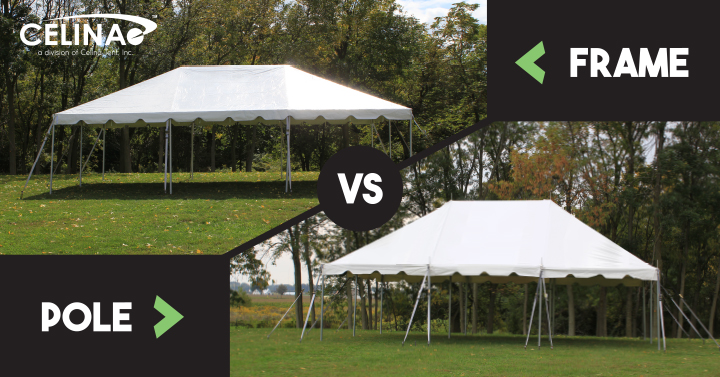
The Difference is Clear: Frames Vs Poles
Structural speaking, there are two main types of tents that Celina sells. These are differentiated by the structures that keep them aloft – either a frame or set of poles. And this is why they are called Pole Tents and Frame Tents.
Thanks for reading!
Oh, you’re still here? I mean, I guess I could go on into more detail if that’s what you want. You’re looking for that? Well, let’s get into it!
Differences!
As you take a deeper peek (*sigh* I guess) at the two styles, you can see that there is a massive amount of separate details that will make or break your installation.
Detail #1: Freestanding Vs Tension
When you assemble a frame tent, the entirety of the frame and the fabric top can exist on its own. Once you assemble and lift it in place on the leg tubes, a frame will support itself. This doesn’t mean you don’t have to anchor it. This just means that the parts that keep the tent aloft are in place and the tent will stand regardless of the state of anchoring. Frame tents must still be anchored to protect guests in case of wind and rain, which can cause the tent to flip or shift at the installation site.
A pole tent will not be able to hold itself up without the guy lines and tensioning system. This is why stakes are installed on pole tents at the beginning of the installation process, where stakes are the last part of a frame tent to be dealt with. The pull from the stakes and guy lines transfers across the tent top fabric and keeps the poles in place – pulling across the tent against the opposite side’s anchoring.
Detail #2: Appearance
Because of the aforementioned anchoring styles, the look of the tents can be vastly different. Any pole tents will most likely have a more smooth and curvy top fabric, since it needs to be pulled tight in order to stay up. Sharp points at the peaks, especially at the center poles, are the hallmark of a pole installation. Frame tents appear more like a house, with the peak and fabric lying across a less highly angled framework. The top attaches to the frame with a series of buckle straps along the perimeter, which can occasionally make it hard to smooth the installed fabric as you can’t pull on it as hard.
Detail #3: Hardware
This one is where you really need to consider why you’re purchasing a tent. While frame tents don’t require tensioning to stay up, the frames used will require a lot more hardware in return. This means more items to store, more to handle and take from place to place, and more that will eventually need replacing. Each section of tubing on a frame tent needs to be pinned to the fitting at the end of each tube; some fittings can have as many as eight separate connections! Having the time and space for installation and storage is a major factor when dealing with frames.
Pole tents require much less in the way of individual pieces of hardware. Common pole canopies are created with a series of side poles, center poles, guy lines, and stakes. Larger sizes will require quarter poles (a mid-length pole on tent ends) and stakes plates/additional stakes to ensure proper staking, but that’s the bulk of the additions.
Even if you have worked with a few tents in the past, it’s never a bad idea to review not only the differences but the WHYs behind these differences. In case you still have questions, go ahead and give us a call at (866) 438-8368. You can also email sales@gettent.com with any other questions you have.

